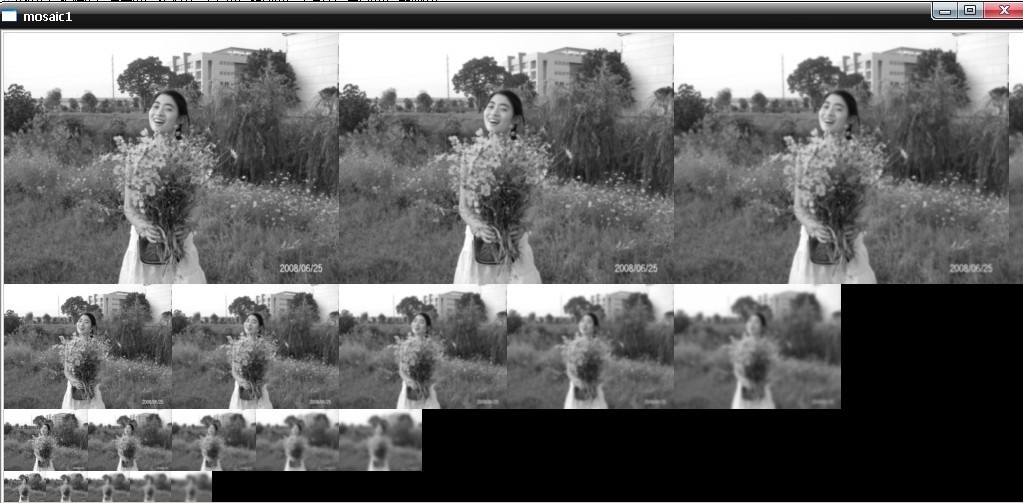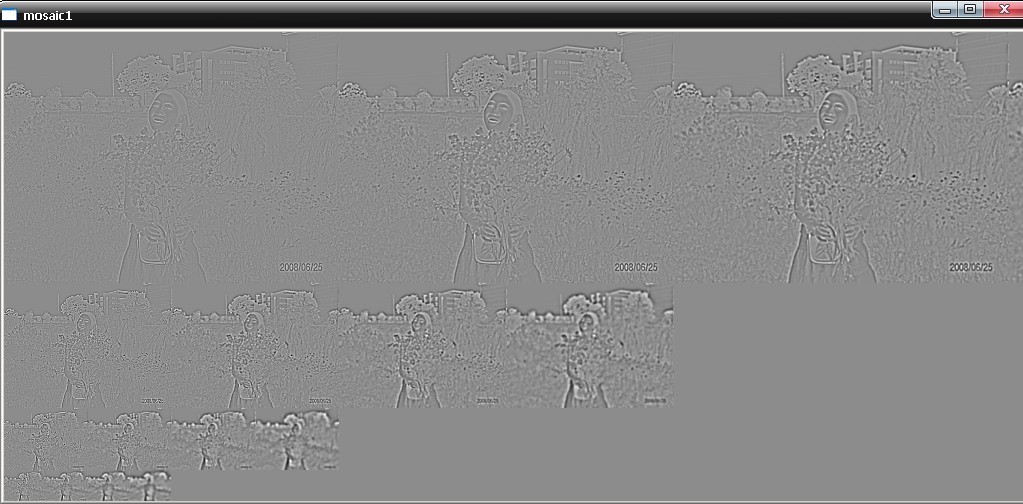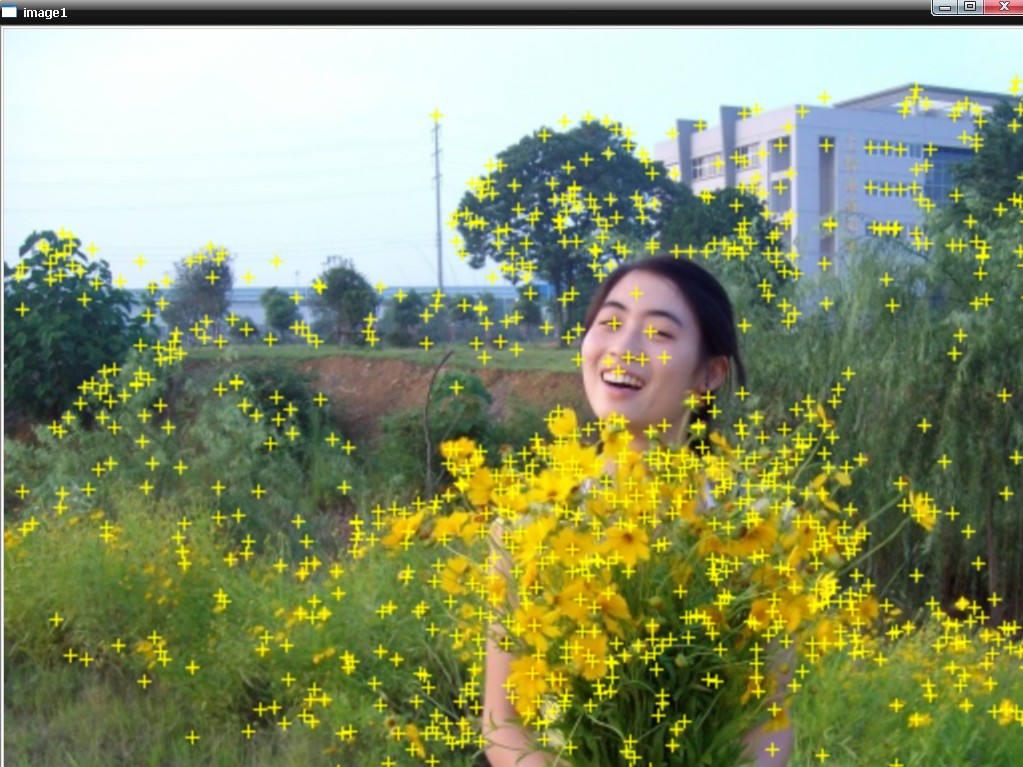- 教你一步一步用c语言实现sift算法、下
- 函数编写
- 五个步骤
- SIFT算法第一步
- SIFT算法第二步
- SIFT算法第三步
- SIFT算法第四步
- SIFT算法第五步
教你一步一步用c语言实现sift算法、下
本文接上,教你一步一步用c语言实现sift算法、上而来:
函数编写
ok,接上文,咱们一个一个的来编写main函数中所涉及到所有函数,这也是本文的关键部分:
//下采样原来的图像,返回缩小2倍尺寸的图像CvMat * halfSizeImage(CvMat * im){unsigned int i,j;int w = im->cols/2;int h = im->rows/2;CvMat *imnew = cvCreateMat(h, w, CV_32FC1);#define Im(ROW,COL) ((float *)(im->data.fl + im->step/sizeof(float) *(ROW)))[(COL)]#define Imnew(ROW,COL) ((float *)(imnew->data.fl + imnew->step/sizeof(float) *(ROW)))[(COL)]for ( j = 0; j < h; j++)for ( i = 0; i < w; i++)Imnew(j,i)=Im(j*2, i*2);return imnew;}//上采样原来的图像,返回放大2倍尺寸的图像CvMat * doubleSizeImage(CvMat * im){unsigned int i,j;int w = im->cols*2;int h = im->rows*2;CvMat *imnew = cvCreateMat(h, w, CV_32FC1);#define Im(ROW,COL) ((float *)(im->data.fl + im->step/sizeof(float) *(ROW)))[(COL)]#define Imnew(ROW,COL) ((float *)(imnew->data.fl + imnew->step/sizeof(float) *(ROW)))[(COL)]for ( j = 0; j < h; j++)for ( i = 0; i < w; i++)Imnew(j,i)=Im(j/2, i/2);return imnew;}//上采样原来的图像,返回放大2倍尺寸的线性插值图像CvMat * doubleSizeImage2(CvMat * im){unsigned int i,j;int w = im->cols*2;int h = im->rows*2;CvMat *imnew = cvCreateMat(h, w, CV_32FC1);#define Im(ROW,COL) ((float *)(im->data.fl + im->step/sizeof(float) *(ROW)))[(COL)]#define Imnew(ROW,COL) ((float *)(imnew->data.fl + imnew->step/sizeof(float) *(ROW)))[(COL)]// fill every pixel so we don't have to worry about skipping pixels laterfor ( j = 0; j < h; j++){for ( i = 0; i < w; i++){Imnew(j,i)=Im(j/2, i/2);}}/*A B CE F GH I Jpixels A C H J are pixels from original imagepixels B E G I F are interpolated pixels*/// interpolate pixels B and Ifor ( j = 0; j < h; j += 2)for ( i = 1; i < w - 1; i += 2)Imnew(j,i)=0.5*(Im(j/2, i/2)+Im(j/2, i/2+1));// interpolate pixels E and Gfor ( j = 1; j < h - 1; j += 2)for ( i = 0; i < w; i += 2)Imnew(j,i)=0.5*(Im(j/2, i/2)+Im(j/2+1, i/2));// interpolate pixel Ffor ( j = 1; j < h - 1; j += 2)for ( i = 1; i < w - 1; i += 2)Imnew(j,i)=0.25*(Im(j/2, i/2)+Im(j/2+1, i/2)+Im(j/2, i/2+1)+Im(j/2+1, i/2+1));return imnew;}//双线性插值,返回像素间的灰度值float getPixelBI(CvMat * im, float col, float row){int irow, icol;float rfrac, cfrac;float row1 = 0, row2 = 0;int width=im->cols;int height=im->rows;#define ImMat(ROW,COL) ((float *)(im->data.fl + im->step/sizeof(float) *(ROW)))[(COL)]irow = (int) row;icol = (int) col;if (irow < 0 || irow >= height|| icol < 0 || icol >= width)return 0;if (row > height - 1)row = height - 1;if (col > width - 1)col = width - 1;rfrac = 1.0 - (row - (float) irow);cfrac = 1.0 - (col - (float) icol);if (cfrac < 1){row1 = cfrac * ImMat(irow,icol) + (1.0 - cfrac) * ImMat(irow,icol+1);}else{row1 = ImMat(irow,icol);}if (rfrac < 1){if (cfrac < 1){row2 = cfrac * ImMat(irow+1,icol) + (1.0 - cfrac) * ImMat(irow+1,icol+1);} else{row2 = ImMat(irow+1,icol);}}return rfrac * row1 + (1.0 - rfrac) * row2;}//矩阵归一化void normalizeMat(CvMat* mat){#define Mat(ROW,COL) ((float *)(mat->data.fl + mat->step/sizeof(float) *(ROW)))[(COL)]float sum = 0;for (unsigned int j = 0; j < mat->rows; j++)for (unsigned int i = 0; i < mat->cols; i++)sum += Mat(j,i);for ( j = 0; j < mat->rows; j++)for (unsigned int i = 0; i < mat->rows; i++)Mat(j,i) /= sum;}//向量归一化void normalizeVec(float* vec, int dim){unsigned int i;float sum = 0;for ( i = 0; i < dim; i++)sum += vec[i];for ( i = 0; i < dim; i++)vec[i] /= sum;}//得到向量的欧式长度,2-范数float GetVecNorm( float* vec, int dim ){float sum=0.0;for (unsigned int i=0;i<dim;i++)sum+=vec[i]*vec[i];return sqrt(sum);}//产生1D高斯核float* GaussianKernel1D(float sigma, int dim){unsigned int i;//printf("GaussianKernel1D(): Creating 1x%d vector for sigma=%.3f gaussian kernel/n", dim, sigma);float *kern=(float*)malloc( dim*sizeof(float) );float s2 = sigma * sigma;int c = dim / 2;float m= 1.0/(sqrt(2.0 * CV_PI) * sigma);double v;for ( i = 0; i < (dim + 1) / 2; i++){v = m * exp(-(1.0*i*i)/(2.0 * s2)) ;kern[c+i] = v;kern[c-i] = v;}// normalizeVec(kern, dim);// for ( i = 0; i < dim; i++)// printf("%f ", kern[i]);// printf("/n");return kern;}//产生2D高斯核矩阵CvMat* GaussianKernel2D(float sigma){// int dim = (int) max(3.0f, GAUSSKERN * sigma);int dim = (int) max(3.0f, 2.0 * GAUSSKERN *sigma + 1.0f);// make dim oddif (dim % 2 == 0)dim++;//printf("GaussianKernel(): Creating %dx%d matrix for sigma=%.3f gaussian/n", dim, dim, sigma);CvMat* mat=cvCreateMat(dim, dim, CV_32FC1);#define Mat(ROW,COL) ((float *)(mat->data.fl + mat->step/sizeof(float) *(ROW)))[(COL)]float s2 = sigma * sigma;int c = dim / 2;//printf("%d %d/n", mat.size(), mat[0].size());float m= 1.0/(sqrt(2.0 * CV_PI) * sigma);for (int i = 0; i < (dim + 1) / 2; i++){for (int j = 0; j < (dim + 1) / 2; j++){//printf("%d %d %d/n", c, i, j);float v = m * exp(-(1.0*i*i + 1.0*j*j) / (2.0 * s2));Mat(c+i,c+j) =v;Mat(c-i,c+j) =v;Mat(c+i,c-j) =v;Mat(c-i,c-j) =v;}}// normalizeMat(mat);return mat;}//x方向像素处作卷积float ConvolveLocWidth(float* kernel, int dim, CvMat * src, int x, int y){#define Src(ROW,COL) ((float *)(src->data.fl + src->step/sizeof(float) *(ROW)))[(COL)]unsigned int i;float pixel = 0;int col;int cen = dim / 2;//printf("ConvolveLoc(): Applying convoluation at location (%d, %d)/n", x, y);for ( i = 0; i < dim; i++){col = x + (i - cen);if (col < 0)col = 0;if (col >= src->cols)col = src->cols - 1;pixel += kernel[i] * Src(y,col);}if (pixel > 1)pixel = 1;return pixel;}//x方向作卷积void Convolve1DWidth(float* kern, int dim, CvMat * src, CvMat * dst){#define DST(ROW,COL) ((float *)(dst->data.fl + dst->step/sizeof(float) *(ROW)))[(COL)]unsigned int i,j;for ( j = 0; j < src->rows; j++){for ( i = 0; i < src->cols; i++){//printf("%d, %d/n", i, j);DST(j,i) = ConvolveLocWidth(kern, dim, src, i, j);}}}//y方向像素处作卷积float ConvolveLocHeight(float* kernel, int dim, CvMat * src, int x, int y){#define Src(ROW,COL) ((float *)(src->data.fl + src->step/sizeof(float) *(ROW)))[(COL)]unsigned int j;float pixel = 0;int cen = dim / 2;//printf("ConvolveLoc(): Applying convoluation at location (%d, %d)/n", x, y);for ( j = 0; j < dim; j++){int row = y + (j - cen);if (row < 0)row = 0;if (row >= src->rows)row = src->rows - 1;pixel += kernel[j] * Src(row,x);}if (pixel > 1)pixel = 1;return pixel;}//y方向作卷积void Convolve1DHeight(float* kern, int dim, CvMat * src, CvMat * dst){#define Dst(ROW,COL) ((float *)(dst->data.fl + dst->step/sizeof(float) *(ROW)))[(COL)]unsigned int i,j;for ( j = 0; j < src->rows; j++){for ( i = 0; i < src->cols; i++){//printf("%d, %d/n", i, j);Dst(j,i) = ConvolveLocHeight(kern, dim, src, i, j);}}}//卷积模糊图像int BlurImage(CvMat * src, CvMat * dst, float sigma){float* convkernel;int dim = (int) max(3.0f, 2.0 * GAUSSKERN * sigma + 1.0f);CvMat *tempMat;// make dim oddif (dim % 2 == 0)dim++;tempMat = cvCreateMat(src->rows, src->cols, CV_32FC1);convkernel = GaussianKernel1D(sigma, dim);Convolve1DWidth(convkernel, dim, src, tempMat);Convolve1DHeight(convkernel, dim, tempMat, dst);cvReleaseMat(&tempMat);return dim;}
五个步骤
ok,接下来,进入重点部分,咱们依据上文介绍的sift算法的几个步骤,来一一实现这些函数。
为了版述清晰,再贴一下,主函数,顺便再加强下对sift 算法的五个步骤的认识:
1、 SIFT算法第一步:图像预处理
CvMat *ScaleInitImage(CvMat * im) ; //金字塔初始化
2、 SIFT算法第二步:建立高斯金字塔函数
ImageOctaves* BuildGaussianOctaves(CvMat * image) ; //建立高斯金字塔
3、 SIFT算法第三步:特征点位置检测,最后确定特征点的位置
int DetectKeypoint(int numoctaves, ImageOctaves *GaussianPyr);
4、 SIFT算法第四步:计算高斯图像的梯度方向和幅值,计算各个特征点的主方向
void ComputeGrad_DirecandMag(int numoctaves, ImageOctaves *GaussianPyr);
5、 SIFT算法第五步:抽取各个特征点处的特征描述字
void ExtractFeatureDescriptors(int numoctaves, ImageOctaves *GaussianPyr);
ok,接下来一一具体实现这几个函数:
SIFT算法第一步
SIFT算法第一步:扩大图像,预滤波剔除噪声,得到金字塔的最底层-第一阶的第一层:
CvMat *ScaleInitImage(CvMat * im){double sigma,preblur_sigma;CvMat *imMat;CvMat * dst;CvMat *tempMat;//首先对图像进行平滑滤波,抑制噪声imMat = cvCreateMat(im->rows, im->cols, CV_32FC1);BlurImage(im, imMat, INITSIGMA);//针对两种情况分别进行处理:初始化放大原始图像或者在原图像基础上进行后续操作//建立金字塔的最底层if (DOUBLE_BASE_IMAGE_SIZE){tempMat = doubleSizeImage2(imMat);//对扩大两倍的图像进行二次采样,采样率为0.5,采用线性插值#define TEMPMAT(ROW,COL) ((float *)(tempMat->data.fl + tempMat->step/sizeof(float) * (ROW)))[(COL)]dst = cvCreateMat(tempMat->rows, tempMat->cols, CV_32FC1);preblur_sigma = 1.0;//sqrt(2 - 4*INITSIGMA*INITSIGMA);BlurImage(tempMat, dst, preblur_sigma);// The initial blurring for the first image of the first octave of the pyramid.sigma = sqrt( (4*INITSIGMA*INITSIGMA) + preblur_sigma * preblur_sigma );// sigma = sqrt(SIGMA * SIGMA - INITSIGMA * INITSIGMA * 4);//printf("Init Sigma: %f/n", sigma);BlurImage(dst, tempMat, sigma); //得到金字塔的最底层-放大2倍的图像cvReleaseMat( &dst );return tempMat;}else{dst = cvCreateMat(im->rows, im->cols, CV_32FC1);//sigma = sqrt(SIGMA * SIGMA - INITSIGMA * INITSIGMA);preblur_sigma = 1.0;//sqrt(2 - 4*INITSIGMA*INITSIGMA);sigma = sqrt( (4*INITSIGMA*INITSIGMA) + preblur_sigma * preblur_sigma );//printf("Init Sigma: %f/n", sigma);BlurImage(imMat, dst, sigma); //得到金字塔的最底层:原始图像大小return dst;}}
SIFT算法第二步
SIFT第二步,建立Gaussian金字塔,给定金字塔第一阶第一层图像后,计算高斯金字塔其他尺度图像,
每一阶的数目由变量SCALESPEROCTAVE决定,给定一个基本图像,计算它的高斯金字塔图像,返回外部向量是阶梯指针,内部向量是每一个阶梯内部的不同尺度图像。
//SIFT算法第二步ImageOctaves* BuildGaussianOctaves(CvMat * image){ImageOctaves *octaves;CvMat *tempMat;CvMat *dst;CvMat *temp;int i,j;double k = pow(2, 1.0/((float)SCALESPEROCTAVE)); //方差倍数float preblur_sigma, initial_sigma , sigma1,sigma2,sigma,absolute_sigma,sigma_f;//计算金字塔的阶梯数目int dim = min(image->rows, image->cols);int numoctaves = (int) (log((double) dim) / log(2.0)) - 2; //金字塔阶数//限定金字塔的阶梯数numoctaves = min(numoctaves, MAXOCTAVES);//为高斯金塔和DOG金字塔分配内存octaves=(ImageOctaves*) malloc( numoctaves * sizeof(ImageOctaves) );DOGoctaves=(ImageOctaves*) malloc( numoctaves * sizeof(ImageOctaves) );printf("BuildGaussianOctaves(): Base image dimension is %dx%d/n", (int)(0.5*(image->cols)), (int)(0.5*(image->rows)) );printf("BuildGaussianOctaves(): Building %d octaves/n", numoctaves);// start with initial source imagetempMat=cvCloneMat( image );// preblur_sigma = 1.0;//sqrt(2 - 4*INITSIGMA*INITSIGMA);initial_sigma = sqrt(2);//sqrt( (4*INITSIGMA*INITSIGMA) + preblur_sigma * preblur_sigma );// initial_sigma = sqrt(SIGMA * SIGMA - INITSIGMA * INITSIGMA * 4);//在每一阶金字塔图像中建立不同的尺度图像for ( i = 0; i < numoctaves; i++){//首先建立金字塔每一阶梯的最底层,其中0阶梯的最底层已经建立好printf("Building octave %d of dimesion (%d, %d)/n", i, tempMat->cols,tempMat->rows);//为各个阶梯分配内存octaves[i].Octave= (ImageLevels*) malloc( (SCALESPEROCTAVE + 3) * sizeof(ImageLevels) );DOGoctaves[i].Octave= (ImageLevels*) malloc( (SCALESPEROCTAVE + 2) * sizeof(ImageLevels) );//存储各个阶梯的最底层(octaves[i].Octave)[0].Level=tempMat;octaves[i].col=tempMat->cols;octaves[i].row=tempMat->rows;DOGoctaves[i].col=tempMat->cols;DOGoctaves[i].row=tempMat->rows;if (DOUBLE_BASE_IMAGE_SIZE)octaves[i].subsample=pow(2,i)*0.5;elseoctaves[i].subsample=pow(2,i);if(i==0){(octaves[0].Octave)[0].levelsigma = initial_sigma;(octaves[0].Octave)[0].absolute_sigma = initial_sigma;printf("0 scale and blur sigma : %f /n", (octaves[0].subsample) * ((octaves[0].Octave)[0].absolute_sigma));}else{(octaves[i].Octave)[0].levelsigma = (octaves[i-1].Octave)[SCALESPEROCTAVE].levelsigma;(octaves[i].Octave)[0].absolute_sigma = (octaves[i-1].Octave)[SCALESPEROCTAVE].absolute_sigma;printf( "0 scale and blur sigma : %f /n", ((octaves[i].Octave)[0].absolute_sigma) );}sigma = initial_sigma;//建立本阶梯其他层的图像for ( j = 1; j < SCALESPEROCTAVE + 3; j++){dst = cvCreateMat(tempMat->rows, tempMat->cols, CV_32FC1);//用于存储高斯层temp = cvCreateMat(tempMat->rows, tempMat->cols, CV_32FC1);//用于存储DOG层// 2 passes of 1D on original// if(i!=0)// {// sigma1 = pow(k, j - 1) * ((octaves[i-1].Octave)[j-1].levelsigma);// sigma2 = pow(k, j) * ((octaves[i].Octave)[j-1].levelsigma);// sigma = sqrt(sigma2*sigma2 - sigma1*sigma1);sigma_f= sqrt(k*k-1)*sigma;// }// else// {// sigma = sqrt(SIGMA * SIGMA - INITSIGMA * INITSIGMA * 4)*pow(k,j);// }sigma = k*sigma;absolute_sigma = sigma * (octaves[i].subsample);printf("%d scale and Blur sigma: %f /n", j, absolute_sigma);(octaves[i].Octave)[j].levelsigma = sigma;(octaves[i].Octave)[j].absolute_sigma = absolute_sigma;//产生高斯层int length=BlurImage((octaves[i].Octave)[j-1].Level, dst, sigma_f);//相应尺度(octaves[i].Octave)[j].levelsigmalength = length;(octaves[i].Octave)[j].Level=dst;//产生DOG层cvSub( ((octaves[i].Octave)[j]).Level, ((octaves[i].Octave)[j-1]).Level, temp, 0 );// cvAbsDiff( ((octaves[i].Octave)[j]).Level, ((octaves[i].Octave)[j-1]).Level, temp );((DOGoctaves[i].Octave)[j-1]).Level=temp;}// halve the image size for next iterationtempMat = halfSizeImage( ( (octaves[i].Octave)[SCALESPEROCTAVE].Level ) );}return octaves;}
SIFT算法第三步
SIFT算法第三步,特征点位置检测,最后确定特征点的位置检测DOG金字塔中的局部最大值,找到之后,还要经过两个检验才能确认为特征点:一是它必须有明显的差异,二是他不应该是边缘点,(也就是说,在极值点处的主曲率比应该小于某一个阈值)。
//SIFT算法第三步,特征点位置检测,int DetectKeypoint(int numoctaves, ImageOctaves *GaussianPyr){//计算用于DOG极值点检测的主曲率比的阈值double curvature_threshold;curvature_threshold= ((CURVATURE_THRESHOLD + 1)*(CURVATURE_THRESHOLD + 1))/CURVATURE_THRESHOLD;#define ImLevels(OCTAVE,LEVEL,ROW,COL) ((float *)(DOGoctaves[(OCTAVE)].Octave[(LEVEL)].Level->data.fl + DOGoctaves[(OCTAVE)].Octave[(LEVEL)].Level->step/sizeof(float) *(ROW)))[(COL)]int keypoint_count = 0;for (int i=0; i<numoctaves; i++){for(int j=1;j<SCALESPEROCTAVE+1;j++)//取中间的scaleperoctave个层{//在图像的有效区域内寻找具有显著性特征的局部最大值//float sigma=(GaussianPyr[i].Octave)[j].levelsigma;//int dim = (int) (max(3.0f, 2.0*GAUSSKERN *sigma + 1.0f)*0.5);int dim = (int)(0.5*((GaussianPyr[i].Octave)[j].levelsigmalength)+0.5);for (int m=dim;m<((DOGoctaves[i].row)-dim);m++)for(int n=dim;n<((DOGoctaves[i].col)-dim);n++){if ( fabs(ImLevels(i,j,m,n))>= CONTRAST_THRESHOLD ){if ( ImLevels(i,j,m,n)!=0.0 ) //1、首先是非零{float inf_val=ImLevels(i,j,m,n);if(( (inf_val <= ImLevels(i,j-1,m-1,n-1))&&(inf_val <= ImLevels(i,j-1,m ,n-1))&&(inf_val <= ImLevels(i,j-1,m+1,n-1))&&(inf_val <= ImLevels(i,j-1,m-1,n ))&&(inf_val <= ImLevels(i,j-1,m ,n ))&&(inf_val <= ImLevels(i,j-1,m+1,n ))&&(inf_val <= ImLevels(i,j-1,m-1,n+1))&&(inf_val <= ImLevels(i,j-1,m ,n+1))&&(inf_val <= ImLevels(i,j-1,m+1,n+1))&& //底层的小尺度9(inf_val <= ImLevels(i,j,m-1,n-1))&&(inf_val <= ImLevels(i,j,m ,n-1))&&(inf_val <= ImLevels(i,j,m+1,n-1))&&(inf_val <= ImLevels(i,j,m-1,n ))&&(inf_val <= ImLevels(i,j,m+1,n ))&&(inf_val <= ImLevels(i,j,m-1,n+1))&&(inf_val <= ImLevels(i,j,m ,n+1))&&(inf_val <= ImLevels(i,j,m+1,n+1))&& //当前层8(inf_val <= ImLevels(i,j+1,m-1,n-1))&&(inf_val <= ImLevels(i,j+1,m ,n-1))&&(inf_val <= ImLevels(i,j+1,m+1,n-1))&&(inf_val <= ImLevels(i,j+1,m-1,n ))&&(inf_val <= ImLevels(i,j+1,m ,n ))&&(inf_val <= ImLevels(i,j+1,m+1,n ))&&(inf_val <= ImLevels(i,j+1,m-1,n+1))&&(inf_val <= ImLevels(i,j+1,m ,n+1))&&(inf_val <= ImLevels(i,j+1,m+1,n+1)) //下一层大尺度9) ||( (inf_val >= ImLevels(i,j-1,m-1,n-1))&&(inf_val >= ImLevels(i,j-1,m ,n-1))&&(inf_val >= ImLevels(i,j-1,m+1,n-1))&&(inf_val >= ImLevels(i,j-1,m-1,n ))&&(inf_val >= ImLevels(i,j-1,m ,n ))&&(inf_val >= ImLevels(i,j-1,m+1,n ))&&(inf_val >= ImLevels(i,j-1,m-1,n+1))&&(inf_val >= ImLevels(i,j-1,m ,n+1))&&(inf_val >= ImLevels(i,j-1,m+1,n+1))&&(inf_val >= ImLevels(i,j,m-1,n-1))&&(inf_val >= ImLevels(i,j,m ,n-1))&&(inf_val >= ImLevels(i,j,m+1,n-1))&&(inf_val >= ImLevels(i,j,m-1,n ))&&(inf_val >= ImLevels(i,j,m+1,n ))&&(inf_val >= ImLevels(i,j,m-1,n+1))&&(inf_val >= ImLevels(i,j,m ,n+1))&&(inf_val >= ImLevels(i,j,m+1,n+1))&&(inf_val >= ImLevels(i,j+1,m-1,n-1))&&(inf_val >= ImLevels(i,j+1,m ,n-1))&&(inf_val >= ImLevels(i,j+1,m+1,n-1))&&(inf_val >= ImLevels(i,j+1,m-1,n ))&&(inf_val >= ImLevels(i,j+1,m ,n ))&&(inf_val >= ImLevels(i,j+1,m+1,n ))&&(inf_val >= ImLevels(i,j+1,m-1,n+1))&&(inf_val >= ImLevels(i,j+1,m ,n+1))&&(inf_val >= ImLevels(i,j+1,m+1,n+1))) ) //2、满足26个中极值点{//此处可存储//然后必须具有明显的显著性,即必须大于CONTRAST_THRESHOLD=0.02if ( fabs(ImLevels(i,j,m,n))>= CONTRAST_THRESHOLD ){//最后显著处的特征点必须具有足够的曲率比,CURVATURE_THRESHOLD=10.0,首先计算Hessian矩阵// Compute the entries of the Hessian matrix at the extrema location./*1 0 -10 0 0-1 0 1 *0.25*/// Compute the trace and the determinant of the Hessian.//Tr_H = Dxx + Dyy;//Det_H = Dxx*Dyy - Dxy^2;float Dxx,Dyy,Dxy,Tr_H,Det_H,curvature_ratio;Dxx = ImLevels(i,j,m,n-1) + ImLevels(i,j,m,n+1)-2.0*ImLevels(i,j,m,n);Dyy = ImLevels(i,j,m-1,n) + ImLevels(i,j,m+1,n)-2.0*ImLevels(i,j,m,n);Dxy = ImLevels(i,j,m-1,n-1) + ImLevels(i,j,m+1,n+1) - ImLevels(i,j,m+1,n-1) - ImLevels(i,j,m-1,n+1);Tr_H = Dxx + Dyy;Det_H = Dxx*Dyy - Dxy*Dxy;// Compute the ratio of the principal curvatures.curvature_ratio = (1.0*Tr_H*Tr_H)/Det_H;if ( (Det_H>=0.0) && (curvature_ratio <= curvature_threshold) ) //最后得到最具有显著性特征的特征点{//将其存储起来,以计算后面的特征描述字keypoint_count++;Keypoint k;/* Allocate memory for the keypoint. */k = (Keypoint) malloc(sizeof(struct KeypointSt));k->next = keypoints;keypoints = k;k->row = m*(GaussianPyr[i].subsample);k->col =n*(GaussianPyr[i].subsample);k->sy = m; //行k->sx = n; //列k->octave=i;k->level=j;k->scale = (GaussianPyr[i].Octave)[j].absolute_sigma;}//if >curvature_thresh}//if >contrast}//if inf value}//if non zero}//if >contrast} //for concrete image level col}//for levels}//for octavesreturn keypoint_count;}//在图像中,显示SIFT特征点的位置void DisplayKeypointLocation(IplImage* image, ImageOctaves *GaussianPyr){Keypoint p = keypoints; // p指向第一个结点while(p) // 没到表尾{cvLine( image, cvPoint((int)((p->col)-3),(int)(p->row)),cvPoint((int)((p->col)+3),(int)(p->row)), CV_RGB(255,255,0),1, 8, 0 );cvLine( image, cvPoint((int)(p->col),(int)((p->row)-3)),cvPoint((int)(p->col),(int)((p->row)+3)), CV_RGB(255,255,0),1, 8, 0 );// cvCircle(image,cvPoint((uchar)(p->col),(uchar)(p->row)),// (int)((GaussianPyr[p->octave].Octave)[p->level].absolute_sigma),// CV_RGB(255,0,0),1,8,0);p=p->next;}}// Compute the gradient direction and magnitude of the gaussian pyramid imagesvoid ComputeGrad_DirecandMag(int numoctaves, ImageOctaves *GaussianPyr){// ImageOctaves *mag_thresh ;mag_pyr=(ImageOctaves*) malloc( numoctaves * sizeof(ImageOctaves) );grad_pyr=(ImageOctaves*) malloc( numoctaves * sizeof(ImageOctaves) );// float sigma=( (GaussianPyr[0].Octave)[SCALESPEROCTAVE+2].absolute_sigma ) / GaussianPyr[0].subsample;// int dim = (int) (max(3.0f, 2 * GAUSSKERN *sigma + 1.0f)*0.5+0.5);#define ImLevels(OCTAVE,LEVEL,ROW,COL) ((float *)(GaussianPyr[(OCTAVE)].Octave[(LEVEL)].Level->data.fl + GaussianPyr[(OCTAVE)].Octave[(LEVEL)].Level->step/sizeof(float) *(ROW)))[(COL)]for (int i=0; i<numoctaves; i++){mag_pyr[i].Octave= (ImageLevels*) malloc( (SCALESPEROCTAVE) * sizeof(ImageLevels) );grad_pyr[i].Octave= (ImageLevels*) malloc( (SCALESPEROCTAVE) * sizeof(ImageLevels) );for(int j=1;j<SCALESPEROCTAVE+1;j++)//取中间的scaleperoctave个层{CvMat *Mag = cvCreateMat(GaussianPyr[i].row, GaussianPyr[i].col, CV_32FC1);CvMat *Ori = cvCreateMat(GaussianPyr[i].row, GaussianPyr[i].col, CV_32FC1);CvMat *tempMat1 = cvCreateMat(GaussianPyr[i].row, GaussianPyr[i].col, CV_32FC1);CvMat *tempMat2 = cvCreateMat(GaussianPyr[i].row, GaussianPyr[i].col, CV_32FC1);cvZero(Mag);cvZero(Ori);cvZero(tempMat1);cvZero(tempMat2);#define MAG(ROW,COL) ((float *)(Mag->data.fl + Mag->step/sizeof(float) *(ROW)))[(COL)]#define ORI(ROW,COL) ((float *)(Ori->data.fl + Ori->step/sizeof(float) *(ROW)))[(COL)]#define TEMPMAT1(ROW,COL) ((float *)(tempMat1->data.fl + tempMat1->step/sizeof(float) *(ROW)))[(COL)]#define TEMPMAT2(ROW,COL) ((float *)(tempMat2->data.fl + tempMat2->step/sizeof(float) *(ROW)))[(COL)]for (int m=1;m<(GaussianPyr[i].row-1);m++)for(int n=1;n<(GaussianPyr[i].col-1);n++){//计算幅值TEMPMAT1(m,n) = 0.5*( ImLevels(i,j,m,n+1)-ImLevels(i,j,m,n-1) ); //dxTEMPMAT2(m,n) = 0.5*( ImLevels(i,j,m+1,n)-ImLevels(i,j,m-1,n) ); //dyMAG(m,n) = sqrt(TEMPMAT1(m,n)*TEMPMAT1(m,n)+TEMPMAT2(m,n)*TEMPMAT2(m,n)); //mag//计算方向ORI(m,n) =atan( TEMPMAT2(m,n)/TEMPMAT1(m,n) );if (ORI(m,n)==CV_PI)ORI(m,n)=-CV_PI;}((mag_pyr[i].Octave)[j-1]).Level=Mag;((grad_pyr[i].Octave)[j-1]).Level=Ori;cvReleaseMat(&tempMat1);cvReleaseMat(&tempMat2);}//for levels}//for octaves}
SIFT算法第四步
//SIFT算法第四步:计算各个特征点的主方向,确定主方向void AssignTheMainOrientation(int numoctaves, ImageOctaves *GaussianPyr,ImageOctaves *mag_pyr,ImageOctaves *grad_pyr){// Set up the histogram bin centers for a 36 bin histogram.int num_bins = 36;float hist_step = 2.0*PI/num_bins;float hist_orient[36];for (int i=0;i<36;i++)hist_orient[i]=-PI+i*hist_step;float sigma1=( ((GaussianPyr[0].Octave)[SCALESPEROCTAVE].absolute_sigma) ) / (GaussianPyr[0].subsample);//SCALESPEROCTAVE+2int zero_pad = (int) (max(3.0f, 2 * GAUSSKERN *sigma1 + 1.0f)*0.5+0.5);//Assign orientations to the keypoints.#define ImLevels(OCTAVES,LEVELS,ROW,COL) ((float *)((GaussianPyr[(OCTAVES)].Octave[(LEVELS)].Level)->data.fl + (GaussianPyr[(OCTAVES)].Octave[(LEVELS)].Level)->step/sizeof(float) *(ROW)))[(COL)]int keypoint_count = 0;Keypoint p = keypoints; // p指向第一个结点while(p) // 没到表尾{int i=p->octave;int j=p->level;int m=p->sy; //行int n=p->sx; //列if ((m>=zero_pad)&&(m<GaussianPyr[i].row-zero_pad)&&(n>=zero_pad)&&(n<GaussianPyr[i].col-zero_pad) ){float sigma=( ((GaussianPyr[i].Octave)[j].absolute_sigma) ) / (GaussianPyr[i].subsample);//产生二维高斯模板CvMat* mat = GaussianKernel2D( sigma );int dim=(int)(0.5 * (mat->rows));//分配用于存储Patch幅值和方向的空间#define MAT(ROW,COL) ((float *)(mat->data.fl + mat->step/sizeof(float) *(ROW)))[(COL)]//声明方向直方图变量double* orienthist = (double *) malloc(36 * sizeof(double));for ( int sw = 0 ; sw < 36 ; ++sw){orienthist[sw]=0.0;}//在特征点的周围统计梯度方向for (int x=m-dim,mm=0;x<=(m+dim);x++,mm++)for(int y=n-dim,nn=0;y<=(n+dim);y++,nn++){//计算特征点处的幅值double dx = 0.5*(ImLevels(i,j,x,y+1)-ImLevels(i,j,x,y-1)); //dxdouble dy = 0.5*(ImLevels(i,j,x+1,y)-ImLevels(i,j,x-1,y)); //dydouble mag = sqrt(dx*dx+dy*dy); //mag//计算方向double Ori =atan( 1.0*dy/dx );int binIdx = FindClosestRotationBin(36, Ori); //得到离现有方向最近的直方块orienthist[binIdx] = orienthist[binIdx] + 1.0* mag * MAT(mm,nn);//利用高斯加权累加进直方图相应的块}// Find peaks in the orientation histogram using nonmax suppression.AverageWeakBins (orienthist, 36);// find the maximum peak in gradient orientationdouble maxGrad = 0.0;int maxBin = 0;for (int b = 0 ; b < 36 ; ++b){if (orienthist[b] > maxGrad){maxGrad = orienthist[b];maxBin = b;}}// First determine the real interpolated peak high at the maximum bin// position, which is guaranteed to be an absolute peak.double maxPeakValue=0.0;double maxDegreeCorrection=0.0;if ( (InterpolateOrientation ( orienthist[maxBin == 0 ? (36 - 1) : (maxBin - 1)],orienthist[maxBin], orienthist[(maxBin + 1) % 36],&maxDegreeCorrection, &maxPeakValue)) == false)printf("BUG: Parabola fitting broken");// Now that we know the maximum peak value, we can find other keypoint// orientations, which have to fulfill two criterias://// 1. They must be a local peak themselves. Else we might add a very// similar keypoint orientation twice (imagine for example the// values: 0.4 1.0 0.8, if 1.0 is maximum peak, 0.8 is still added// with the default threshhold, but the maximum peak orientation// was already added).// 2. They must have at least peakRelThresh times the maximum peak// value.bool binIsKeypoint[36];for ( b = 0 ; b < 36 ; ++b){binIsKeypoint[b] = false;// The maximum peak of course isif (b == maxBin){binIsKeypoint[b] = true;continue;}// Local peaks are, too, in case they fulfill the threshholdif (orienthist[b] < (peakRelThresh * maxPeakValue))continue;int leftI = (b == 0) ? (36 - 1) : (b - 1);int rightI = (b + 1) % 36;if (orienthist[b] <= orienthist[leftI] || orienthist[b] <= orienthist[rightI])continue; // no local peakbinIsKeypoint[b] = true;}// find other possible locationsdouble oneBinRad = (2.0 * PI) / 36;for ( b = 0 ; b < 36 ; ++b){if (binIsKeypoint[b] == false)continue;int bLeft = (b == 0) ? (36 - 1) : (b - 1);int bRight = (b + 1) % 36;// Get an interpolated peak direction and value guess.double peakValue;double degreeCorrection;double maxPeakValue, maxDegreeCorrection;if (InterpolateOrientation ( orienthist[maxBin == 0 ? (36 - 1) : (maxBin - 1)],orienthist[maxBin], orienthist[(maxBin + 1) % 36],°reeCorrection, &peakValue) == false){printf("BUG: Parabola fitting broken");}double degree = (b + degreeCorrection) * oneBinRad - PI;if (degree < -PI)degree += 2.0 * PI;else if (degree > PI)degree -= 2.0 * PI;//存储方向,可以直接利用检测到的链表进行该步主方向的指定;//分配内存重新存储特征点Keypoint k;/* Allocate memory for the keypoint Descriptor. */k = (Keypoint) malloc(sizeof(struct KeypointSt));k->next = keyDescriptors;keyDescriptors = k;k->descrip = (float*)malloc(LEN * sizeof(float));k->row = p->row;k->col = p->col;k->sy = p->sy; //行k->sx = p->sx; //列k->octave = p->octave;k->level = p->level;k->scale = p->scale;k->ori = degree;k->mag = peakValue;}//forfree(orienthist);}p=p->next;}}//寻找与方向直方图最近的柱,确定其indexint FindClosestRotationBin (int binCount, float angle){angle += CV_PI;angle /= 2.0 * CV_PI;// calculate the aligned binangle *= binCount;int idx = (int) angle;if (idx == binCount)idx = 0;return (idx);}// Average the content of the direction bins.void AverageWeakBins (double* hist, int binCount){// TODO: make some tests what number of passes is the best. (its clear// one is not enough, as we may have something like// ( 0.4, 0.4, 0.3, 0.4, 0.4 ))for (int sn = 0 ; sn < 2 ; ++sn){double firstE = hist[0];double last = hist[binCount-1];for (int sw = 0 ; sw < binCount ; ++sw){double cur = hist[sw];double next = (sw == (binCount - 1)) ? firstE : hist[(sw + 1) % binCount];hist[sw] = (last + cur + next) / 3.0;last = cur;}}}// Fit a parabol to the three points (-1.0 ; left), (0.0 ; middle) and// (1.0 ; right).// Formulas:// f(x) = a (x - c)^2 + b// c is the peak offset (where f'(x) is zero), b is the peak value.// In case there is an error false is returned, otherwise a correction// value between [-1 ; 1] is returned in 'degreeCorrection', where -1// means the peak is located completely at the left vector, and -0.5 just// in the middle between left and middle and > 0 to the right side. In// 'peakValue' the maximum estimated peak value is stored.bool InterpolateOrientation (double left, double middle,double right, double *degreeCorrection, double *peakValue){double a = ((left + right) - 2.0 * middle) / 2.0; //抛物线捏合系数a// degreeCorrection = peakValue = Double.NaN;// Not a parabolif (a == 0.0)return false;double c = (((left - middle) / a) - 1.0) / 2.0;double b = middle - c * c * a;if (c < -0.5 || c > 0.5)return false;*degreeCorrection = c;*peakValue = b;return true;}//显示特征点处的主方向void DisplayOrientation (IplImage* image, ImageOctaves *GaussianPyr){Keypoint p = keyDescriptors; // p指向第一个结点while(p) // 没到表尾{float scale=(GaussianPyr[p->octave].Octave)[p->level].absolute_sigma;float autoscale = 3.0;float uu=autoscale*scale*cos(p->ori);float vv=autoscale*scale*sin(p->ori);float x=(p->col)+uu;float y=(p->row)+vv;cvLine( image, cvPoint((int)(p->col),(int)(p->row)),cvPoint((int)x,(int)y), CV_RGB(255,255,0),1, 8, 0 );// Arrow head parametersfloat alpha = 0.33; // Size of arrow head relative to the length of the vectorfloat beta = 0.33; // Width of the base of the arrow head relative to the lengthfloat xx0= (p->col)+uu-alpha*(uu+beta*vv);float yy0= (p->row)+vv-alpha*(vv-beta*uu);float xx1= (p->col)+uu-alpha*(uu-beta*vv);float yy1= (p->row)+vv-alpha*(vv+beta*uu);cvLine( image, cvPoint((int)xx0,(int)yy0),cvPoint((int)x,(int)y), CV_RGB(255,255,0),1, 8, 0 );cvLine( image, cvPoint((int)xx1,(int)yy1),cvPoint((int)x,(int)y), CV_RGB(255,255,0),1, 8, 0 );p=p->next;}}
SIFT算法第五步
SIFT算法第五步:抽取各个特征点处的特征描述字,确定特征点的描述字。描述字是Patch网格内梯度方向的描述,旋转网格到主方向,插值得到网格处梯度值。
一个特征点可以用228=32维的向量,也可以用448=128维的向量更精确的进行描述。
void ExtractFeatureDescriptors(int numoctaves, ImageOctaves *GaussianPyr){// The orientation histograms have 8 binsfloat orient_bin_spacing = PI/4;float orient_angles[8]={-PI,-PI+orient_bin_spacing,-PI*0.5, -orient_bin_spacing,0.0, orient_bin_spacing, PI*0.5, PI+orient_bin_spacing};//产生描述字中心各点坐标float *feat_grid=(float *) malloc( 2*16 * sizeof(float));for (int i=0;i<GridSpacing;i++){for (int j=0;j<2*GridSpacing;++j,++j){feat_grid[i*2*GridSpacing+j]=-6.0+i*GridSpacing;feat_grid[i*2*GridSpacing+j+1]=-6.0+0.5*j*GridSpacing;}}//产生网格float *feat_samples=(float *) malloc( 2*256 * sizeof(float));for ( i=0;i<4*GridSpacing;i++){for (int j=0;j<8*GridSpacing;j+=2){feat_samples[i*8*GridSpacing+j]=-(2*GridSpacing-0.5)+i;feat_samples[i*8*GridSpacing+j+1]=-(2*GridSpacing-0.5)+0.5*j;}}float feat_window = 2*GridSpacing;Keypoint p = keyDescriptors; // p指向第一个结点while(p) // 没到表尾{float scale=(GaussianPyr[p->octave].Octave)[p->level].absolute_sigma;float sine = sin(p->ori);float cosine = cos(p->ori);//计算中心点坐标旋转之后的位置float *featcenter=(float *) malloc( 2*16 * sizeof(float));for (int i=0;i<GridSpacing;i++){for (int j=0;j<2*GridSpacing;j+=2){float x=feat_grid[i*2*GridSpacing+j];float y=feat_grid[i*2*GridSpacing+j+1];featcenter[i*2*GridSpacing+j]=((cosine * x + sine * y) + p->sx);featcenter[i*2*GridSpacing+j+1]=((-sine * x + cosine * y) + p->sy);}}// calculate sample window coordinates (rotated along keypoint)float *feat=(float *) malloc( 2*256 * sizeof(float));for ( i=0;i<64*GridSpacing;i++,i++){float x=feat_samples[i];float y=feat_samples[i+1];feat[i]=((cosine * x + sine * y) + p->sx);feat[i+1]=((-sine * x + cosine * y) + p->sy);}//Initialize the feature descriptor.float *feat_desc = (float *) malloc( 128 * sizeof(float));for (i=0;i<128;i++){feat_desc[i]=0.0;// printf("%f ",feat_desc[i]);}//printf("/n");for ( i=0;i<512;++i,++i){float x_sample = feat[i];float y_sample = feat[i+1];// Interpolate the gradient at the sample position/*0 1 01 * 10 1 0 具体插值策略如图示*/float sample12=getPixelBI(((GaussianPyr[p->octave].Octave)[p->level]).Level, x_sample, y_sample-1);float sample21=getPixelBI(((GaussianPyr[p->octave].Octave)[p->level]).Level, x_sample-1, y_sample);float sample22=getPixelBI(((GaussianPyr[p->octave].Octave)[p->level]).Level, x_sample, y_sample);float sample23=getPixelBI(((GaussianPyr[p->octave].Octave)[p->level]).Level, x_sample+1, y_sample);float sample32=getPixelBI(((GaussianPyr[p->octave].Octave)[p->level]).Level, x_sample, y_sample+1);//float diff_x = 0.5*(sample23 - sample21);//float diff_y = 0.5*(sample32 - sample12);float diff_x = sample23 - sample21;float diff_y = sample32 - sample12;float mag_sample = sqrt( diff_x*diff_x + diff_y*diff_y );float grad_sample = atan( diff_y / diff_x );if(grad_sample == CV_PI)grad_sample = -CV_PI;// Compute the weighting for the x and y dimensions.float *x_wght=(float *) malloc( GridSpacing * GridSpacing * sizeof(float));float *y_wght=(float *) malloc( GridSpacing * GridSpacing * sizeof(float));float *pos_wght=(float *) malloc( 8*GridSpacing * GridSpacing * sizeof(float));;for (int m=0;m<32;++m,++m){float x=featcenter[m];float y=featcenter[m+1];x_wght[m/2] = max(1 - (fabs(x - x_sample)*1.0/GridSpacing), 0);y_wght[m/2] = max(1 - (fabs(y - y_sample)*1.0/GridSpacing), 0);}for ( m=0;m<16;++m)for (int n=0;n<8;++n)pos_wght[m*8+n]=x_wght[m]*y_wght[m];free(x_wght);free(y_wght);//计算方向的加权,首先旋转梯度场到主方向,然后计算差异float diff[8],orient_wght[128];for ( m=0;m<8;++m){float angle = grad_sample-(p->ori)-orient_angles[m]+CV_PI;float temp = angle / (2.0 * CV_PI);angle -= (int)(temp) * (2.0 * CV_PI);diff[m]= angle - CV_PI;}// Compute the gaussian weighting.float x=p->sx;float y=p->sy;float g = exp(-((x_sample-x)*(x_sample-x)+(y_sample-y)*(y_sample-y))/(2*feat_window*feat_window))/(2*CV_PI*feat_window*feat_window);for ( m=0;m<128;++m){orient_wght[m] = max((1.0 - 1.0*fabs(diff[m%8])/orient_bin_spacing),0);feat_desc[m] = feat_desc[m] + orient_wght[m]*pos_wght[m]*g*mag_sample;}free(pos_wght);}free(feat);free(featcenter);float norm=GetVecNorm( feat_desc, 128);for (int m=0;m<128;m++){feat_desc[m]/=norm;if (feat_desc[m]>0.2)feat_desc[m]=0.2;}norm=GetVecNorm( feat_desc, 128);for ( m=0;m<128;m++){feat_desc[m]/=norm;printf("%f ",feat_desc[m]);}printf("/n");p->descrip = feat_desc;p=p->next;}free(feat_grid);free(feat_samples);}//为了显示图象金字塔,而作的图像水平拼接CvMat* MosaicHorizen( CvMat* im1, CvMat* im2 ){int row,col;CvMat *mosaic = cvCreateMat( max(im1->rows,im2->rows),(im1->cols+im2->cols),CV_32FC1);#define Mosaic(ROW,COL) ((float*)(mosaic->data.fl + mosaic->step/sizeof(float)*(ROW)))[(COL)]#define Im11Mat(ROW,COL) ((float *)(im1->data.fl + im1->step/sizeof(float) *(ROW)))[(COL)]#define Im22Mat(ROW,COL) ((float *)(im2->data.fl + im2->step/sizeof(float) *(ROW)))[(COL)]cvZero(mosaic);/* Copy images into mosaic1. */for ( row = 0; row < im1->rows; row++)for ( col = 0; col < im1->cols; col++)Mosaic(row,col)=Im11Mat(row,col) ;for ( row = 0; row < im2->rows; row++)for ( col = 0; col < im2->cols; col++)Mosaic(row, (col+im1->cols) )= Im22Mat(row,col) ;return mosaic;}//为了显示图象金字塔,而作的图像垂直拼接CvMat* MosaicVertical( CvMat* im1, CvMat* im2 ){int row,col;CvMat *mosaic = cvCreateMat(im1->rows+im2->rows,max(im1->cols,im2->cols), CV_32FC1);#define Mosaic(ROW,COL) ((float*)(mosaic->data.fl + mosaic->step/sizeof(float)*(ROW)))[(COL)]#define Im11Mat(ROW,COL) ((float *)(im1->data.fl + im1->step/sizeof(float) *(ROW)))[(COL)]#define Im22Mat(ROW,COL) ((float *)(im2->data.fl + im2->step/sizeof(float) *(ROW)))[(COL)]cvZero(mosaic);/* Copy images into mosaic1. */for ( row = 0; row < im1->rows; row++)for ( col = 0; col < im1->cols; col++)Mosaic(row,col)= Im11Mat(row,col) ;for ( row = 0; row < im2->rows; row++)for ( col = 0; col < im2->cols; col++)Mosaic((row+im1->rows),col)=Im22Mat(row,col) ;return mosaic;}
ok,为了版述清晰,再贴一下上文所述的主函数(注,上文已贴出,此是为了版述清晰,重复造轮):
int main( void ){//声明当前帧IplImage指针IplImage* src = NULL;IplImage* image1 = NULL;IplImage* grey_im1 = NULL;IplImage* DoubleSizeImage = NULL;IplImage* mosaic1 = NULL;IplImage* mosaic2 = NULL;CvMat* mosaicHorizen1 = NULL;CvMat* mosaicHorizen2 = NULL;CvMat* mosaicVertical1 = NULL;CvMat* image1Mat = NULL;CvMat* tempMat=NULL;ImageOctaves *Gaussianpyr;int rows,cols;#define Im1Mat(ROW,COL) ((float *)(image1Mat->data.fl + image1Mat->step/sizeof(float) *(ROW)))[(COL)]//灰度图象像素的数据结构#define Im1B(ROW,COL) ((uchar*)(image1->imageData + image1->widthStep*(ROW)))[(COL)*3]#define Im1G(ROW,COL) ((uchar*)(image1->imageData + image1->widthStep*(ROW)))[(COL)*3+1]#define Im1R(ROW,COL) ((uchar*)(image1->imageData + image1->widthStep*(ROW)))[(COL)*3+2]storage = cvCreateMemStorage(0);//读取图片if( (src = cvLoadImage( "street1.jpg", 1)) == 0 ) // test1.jpg einstein.pgm back1.bmpreturn -1;//为图像分配内存image1 = cvCreateImage(cvSize(src->width, src->height), IPL_DEPTH_8U,3);grey_im1 = cvCreateImage(cvSize(src->width, src->height), IPL_DEPTH_8U,1);DoubleSizeImage = cvCreateImage(cvSize(2*(src->width), 2*(src->height)), IPL_DEPTH_8U,3);//为图像阵列分配内存,假设两幅图像的大小相同,tempMat跟随image1的大小image1Mat = cvCreateMat(src->height, src->width, CV_32FC1);//转化成单通道图像再处理cvCvtColor(src, grey_im1, CV_BGR2GRAY);//转换进入Mat数据结构,图像操作使用的是浮点型操作cvConvert(grey_im1, image1Mat);double t = (double)cvGetTickCount();//图像归一化cvConvertScale( image1Mat, image1Mat, 1.0/255, 0 );int dim = min(image1Mat->rows, image1Mat->cols);numoctaves = (int) (log((double) dim) / log(2.0)) - 2; //金字塔阶数numoctaves = min(numoctaves, MAXOCTAVES);//SIFT算法第一步,预滤波除噪声,建立金字塔底层tempMat = ScaleInitImage(image1Mat) ;//SIFT算法第二步,建立Guassian金字塔和DOG金字塔Gaussianpyr = BuildGaussianOctaves(tempMat) ;t = (double)cvGetTickCount() - t;printf( "the time of build Gaussian pyramid and DOG pyramid is %.1f/n", t/(cvGetTickFrequency()*1000.) );#define ImLevels(OCTAVE,LEVEL,ROW,COL) ((float *)(Gaussianpyr[(OCTAVE)].Octave[(LEVEL)].Level->data.fl + Gaussianpyr[(OCTAVE)].Octave[(LEVEL)].Level->step/sizeof(float) *(ROW)))[(COL)]//显示高斯金字塔for (int i=0; i<numoctaves;i++){if (i==0){mosaicHorizen1=MosaicHorizen( (Gaussianpyr[0].Octave)[0].Level, (Gaussianpyr[0].Octave)[1].Level );for (int j=2;j<SCALESPEROCTAVE+3;j++)mosaicHorizen1=MosaicHorizen( mosaicHorizen1, (Gaussianpyr[0].Octave)[j].Level );for ( j=0;j<NUMSIZE;j++)mosaicHorizen1=halfSizeImage(mosaicHorizen1);}else if (i==1){mosaicHorizen2=MosaicHorizen( (Gaussianpyr[1].Octave)[0].Level, (Gaussianpyr[1].Octave)[1].Level );for (int j=2;j<SCALESPEROCTAVE+3;j++)mosaicHorizen2=MosaicHorizen( mosaicHorizen2, (Gaussianpyr[1].Octave)[j].Level );for ( j=0;j<NUMSIZE;j++)mosaicHorizen2=halfSizeImage(mosaicHorizen2);mosaicVertical1=MosaicVertical( mosaicHorizen1, mosaicHorizen2 );}else{mosaicHorizen1=MosaicHorizen( (Gaussianpyr[i].Octave)[0].Level, (Gaussianpyr[i].Octave)[1].Level );for (int j=2;j<SCALESPEROCTAVE+3;j++)mosaicHorizen1=MosaicHorizen( mosaicHorizen1, (Gaussianpyr[i].Octave)[j].Level );for ( j=0;j<NUMSIZE;j++)mosaicHorizen1=halfSizeImage(mosaicHorizen1);mosaicVertical1=MosaicVertical( mosaicVertical1, mosaicHorizen1 );}}mosaic1 = cvCreateImage(cvSize(mosaicVertical1->width, mosaicVertical1->height), IPL_DEPTH_8U,1);cvConvertScale( mosaicVertical1, mosaicVertical1, 255.0, 0 );cvConvertScaleAbs( mosaicVertical1, mosaic1, 1, 0 );// cvSaveImage("GaussianPyramid of me.jpg",mosaic1);cvNamedWindow("mosaic1",1);cvShowImage("mosaic1", mosaic1);cvWaitKey(0);cvDestroyWindow("mosaic1");//显示DOG金字塔for ( i=0; i<numoctaves;i++){if (i==0){mosaicHorizen1=MosaicHorizen( (DOGoctaves[0].Octave)[0].Level, (DOGoctaves[0].Octave)[1].Level );for (int j=2;j<SCALESPEROCTAVE+2;j++)mosaicHorizen1=MosaicHorizen( mosaicHorizen1, (DOGoctaves[0].Octave)[j].Level );for ( j=0;j<NUMSIZE;j++)mosaicHorizen1=halfSizeImage(mosaicHorizen1);}else if (i==1){mosaicHorizen2=MosaicHorizen( (DOGoctaves[1].Octave)[0].Level, (DOGoctaves[1].Octave)[1].Level );for (int j=2;j<SCALESPEROCTAVE+2;j++)mosaicHorizen2=MosaicHorizen( mosaicHorizen2, (DOGoctaves[1].Octave)[j].Level );for ( j=0;j<NUMSIZE;j++)mosaicHorizen2=halfSizeImage(mosaicHorizen2);mosaicVertical1=MosaicVertical( mosaicHorizen1, mosaicHorizen2 );}else{mosaicHorizen1=MosaicHorizen( (DOGoctaves[i].Octave)[0].Level, (DOGoctaves[i].Octave)[1].Level );for (int j=2;j<SCALESPEROCTAVE+2;j++)mosaicHorizen1=MosaicHorizen( mosaicHorizen1, (DOGoctaves[i].Octave)[j].Level );for ( j=0;j<NUMSIZE;j++)mosaicHorizen1=halfSizeImage(mosaicHorizen1);mosaicVertical1=MosaicVertical( mosaicVertical1, mosaicHorizen1 );}}//考虑到DOG金字塔各层图像都会有正负,所以,必须寻找最负的,以将所有图像抬高一个台阶去显示double min_val=0;double max_val=0;cvMinMaxLoc( mosaicVertical1, &min_val, &max_val,NULL, NULL, NULL );if ( min_val<0.0 )cvAddS( mosaicVertical1, cvScalarAll( (-1.0)*min_val ), mosaicVertical1, NULL );mosaic2 = cvCreateImage(cvSize(mosaicVertical1->width, mosaicVertical1->height), IPL_DEPTH_8U,1);cvConvertScale( mosaicVertical1, mosaicVertical1, 255.0/(max_val-min_val), 0 );cvConvertScaleAbs( mosaicVertical1, mosaic2, 1, 0 );// cvSaveImage("DOGPyramid of me.jpg",mosaic2);cvNamedWindow("mosaic1",1);cvShowImage("mosaic1", mosaic2);cvWaitKey(0);//SIFT算法第三步:特征点位置检测,最后确定特征点的位置int keycount=DetectKeypoint(numoctaves, Gaussianpyr);printf("the keypoints number are %d ;/n", keycount);cvCopy(src,image1,NULL);DisplayKeypointLocation( image1 ,Gaussianpyr);cvPyrUp( image1, DoubleSizeImage, CV_GAUSSIAN_5x5 );cvNamedWindow("image1",1);cvShowImage("image1", DoubleSizeImage);cvWaitKey(0);cvDestroyWindow("image1");//SIFT算法第四步:计算高斯图像的梯度方向和幅值,计算各个特征点的主方向ComputeGrad_DirecandMag(numoctaves, Gaussianpyr);AssignTheMainOrientation( numoctaves, Gaussianpyr,mag_pyr,grad_pyr);cvCopy(src,image1,NULL);DisplayOrientation ( image1, Gaussianpyr);// cvPyrUp( image1, DoubleSizeImage, CV_GAUSSIAN_5x5 );cvNamedWindow("image1",1);// cvResizeWindow("image1", 2*(image1->width), 2*(image1->height) );cvShowImage("image1", image1);cvWaitKey(0);//SIFT算法第五步:抽取各个特征点处的特征描述字ExtractFeatureDescriptors( numoctaves, Gaussianpyr);cvWaitKey(0);//销毁窗口cvDestroyWindow("image1");cvDestroyWindow("mosaic1");//释放图像cvReleaseImage(&image1);cvReleaseImage(&grey_im1);cvReleaseImage(&mosaic1);cvReleaseImage(&mosaic2);return 0;}
最后,再看一下,运行效果(图中美女为老乡+朋友,何姐08年照):





完。
updated
有很多朋友都在本文评论下要求要本程序的完整源码包(注:本文代码未贴全,复制粘贴编译肯定诸多错误),但由于时隔太久,这份代码我自己也找不到了,不过,我可以提供一份sift + KD + BBF,且可以编译正确的代码供大家参考学习,有pudn帐号的朋友可以前去下载:http://www.pudn.com/downloads340/sourcecode/graph/texture_mapping/detail1486667.html (没有pudn账号的同学请加群:169056165,验证信息:sift,至群共享下载),然后用两幅不同的图片做了下匹配(当然,运行结果显示是不匹配的),效果还不错:http://weibo.com/1580904460/yDmzAEwcV#1348475194313! July、二零一二年十月十一日。
